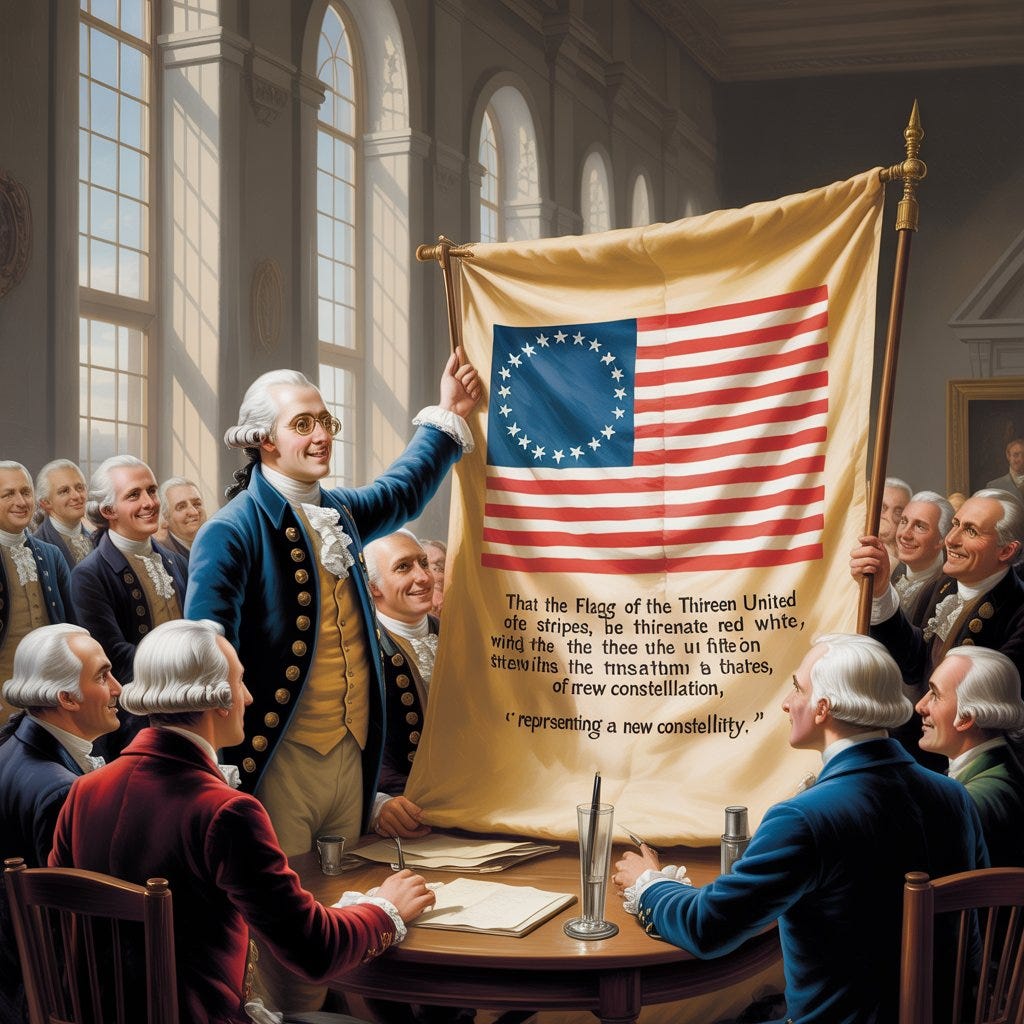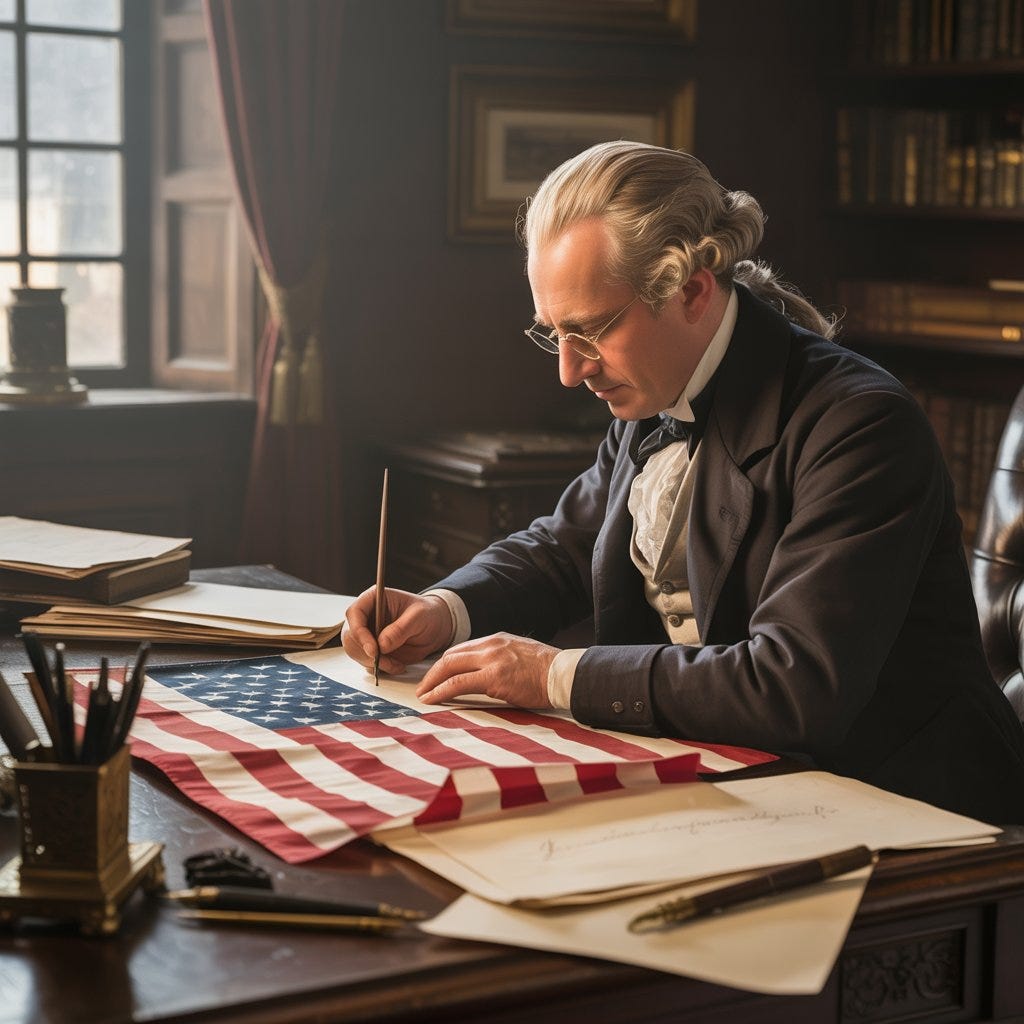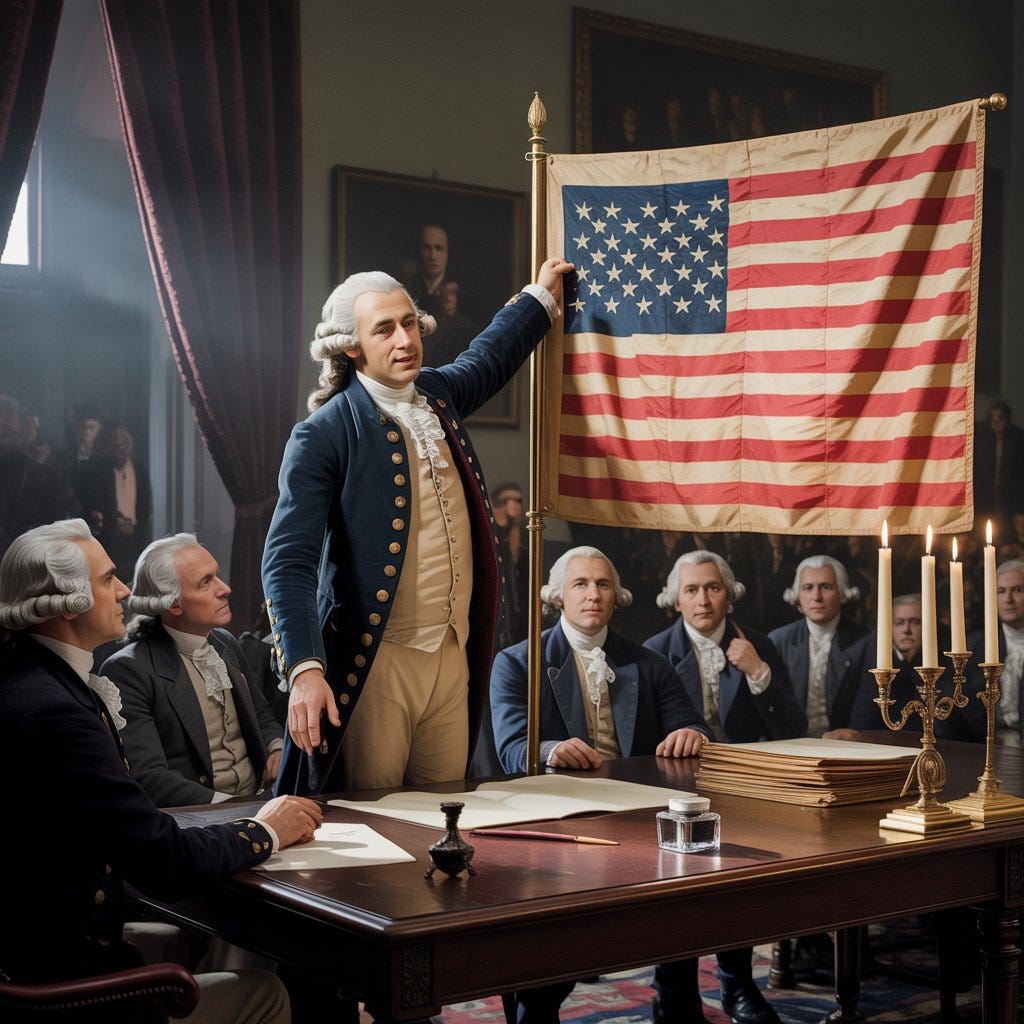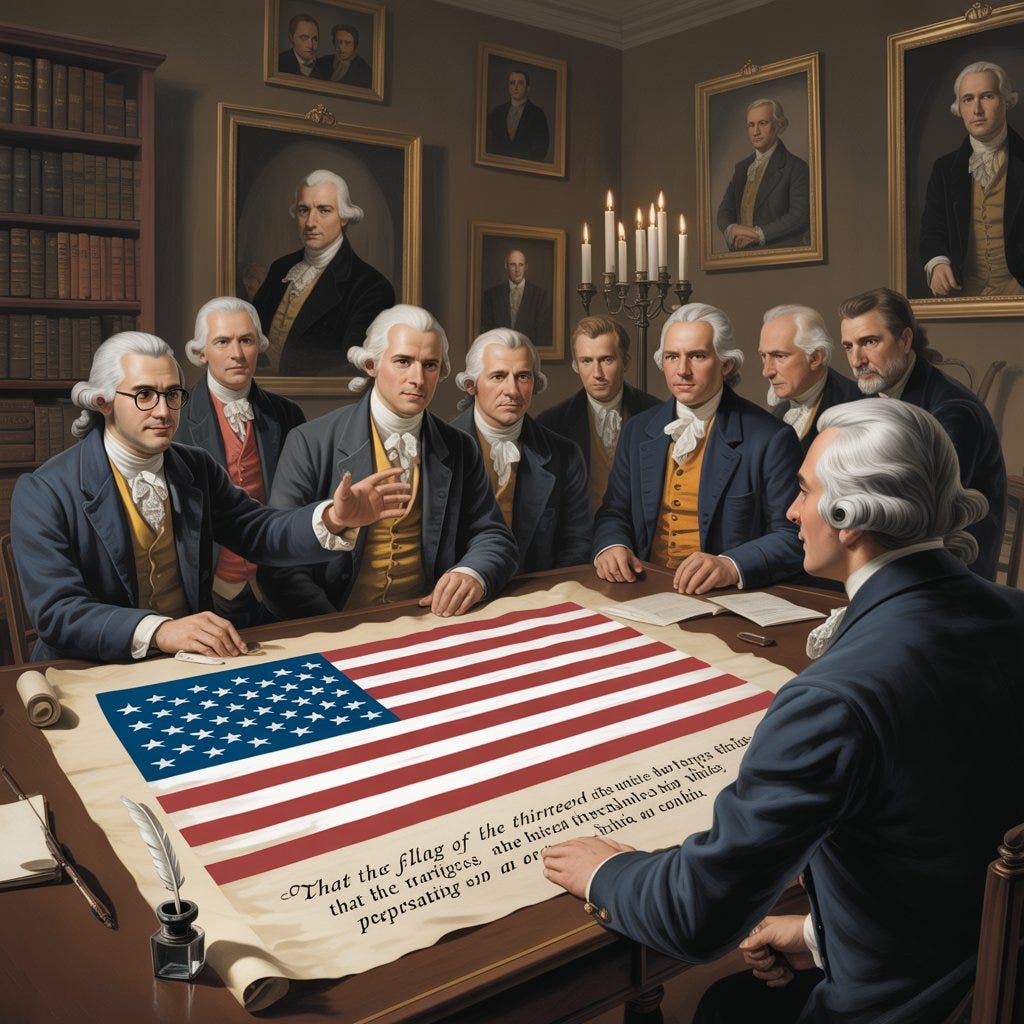The True Creator of the American Flag
Francis Hopkinson’s Unsung Legacy and Reflections on Intellectual Property
Happy Fourth of July, Independence Day!
The myth of Betsy Ross stitching the first American flag has woven itself into the fabric of our national lore, a heartwarming tale of a humble seamstress contributing to the birth of a nation.1 But this narrative confirmed a pattern of undervaluing intellectual labor that echoes through American history.
Cast aside sentimental fables and confront the truth: the Betsy Ross story is a latecomer to history, surfacing nearly a century after the fact in 1870, through the dubious recollections of her grandson, William Canby.2 The real story of the American flag’s origin is not only more compelling but also reveals a profound truth about the men who shaped our nation’s identity—a truth rooted in intellect, creativity, and a bold vision for a fledgling republic. The true architect of the American flag was not a seamstress but a polymath, a patriot, and a forgotten giant of the American Revolution: Francis Hopkinson.3
Hopkinson was no mere bystander in the saga of American independence. A signer of the Declaration of Independence, a poet whose verses stirred the hearts of patriots, an artist whose designs captured the spirit of a new nation, and the chairman of the Continental Navy Board, Hopkinson was a Renaissance man of the Revolution. In 1780, he submitted a detailed memorandum to Congress, meticulously cataloging his contributions to the American cause. Among them was a claim that should echo through history: he designed “the Flag of the United States.”4 This was no idle boast. On June 14, 1777, the Second Continental Congress passed the Flag Resolution, declaring, “That the flag of the thirteen United States be thirteen stripes, alternate red and white; that the union be thirteen stars, white in a blue field, representing a new constellation.”5 While Congress provided the framework, it was Hopkinson who gave it form, translating abstract ideals into a visual emblem that would endure for centuries.
What makes Hopkinson’s contribution all the more fascinating is what he requested in return: payment. In an era when men of means often served without expectation of reward, Hopkinson’s appeal for compensation was not mercenary but principled. He sought “a Quarter Cask of the Public Wine” as a modest token for his extensive services, which included not only the flag but also seals, currency designs, and other symbols of national identity.6 This request reveals a man who understood the value of his intellectual labor and was unafraid to assert it, even in the face of a Congress strapped for resources. It speaks to a broader truth about the American experiment: the creation of a nation required not just blood and sacrifice but the quiet, often unrecognized work of visionaries who crafted its symbols and systems.
Hopkinson’s role in designing the flag was not a solitary act but part of a larger tapestry of contributions that shaped the American identity.7 His leadership in naval affairs demonstrates a man whose influence permeated the Revolution’s cultural and political spheres.8 Yet, Congress, in its frugality or oversight, declined to fully compensate him, leaving his legacy to languish in obscurity while the Betsy Ross myth gained traction. This injustice mirrors a recurring theme in history: the true architects of civilization are often overshadowed by simpler, more palatable narratives.
His broader contributions compound the injustice. Beyond the flag, Hopkinson's work on the Great Seal of the United States³ and his satirical writings that mobilized public opinion for independence⁴ demonstrate the comprehensive nature of his intellectual contributions to American identity. His 1774 satirical allegory "A Pretty Story" effectively rallied public support for the revolutionary cause by depicting British-American relations as a deteriorating family relationship corrupted by parliamentary greed.⁵ Yet these achievements, like his flag design, were subsumed into the broader narrative of collective achievement, with individual credit deemed somehow unpatriotic.
In the annals of American intellectual property disputes, few cases illuminate our nation's conflicted relationship with creative compensation quite like the forgotten saga of Francis Hopkinson and his flag design claim. Here was a man who helped birth the visual identity of a nation, yet found himself dismissed by the very institution he sought to serve—a precursor to countless modern battles over digital rights, design patents, and the elusive nature of intellectual property valuation.
Most historians credit Francis Hopkinson as the designer of the American flag.9 Yet when Hopkinson submitted his modest billing to Congress in 1780—requesting payment in the form of alcohol for his design work—he was met with the kind of bureaucratic stonewalling that would make any modern freelancer nod in grim recognition.² The Board of Treasury ultimately refused his claim, despite his documented contributions to the nation's visual identity.
The parallels to today's intellectual property landscape are striking. Consider the modern creator economy, where designers routinely struggle to assert ownership over their work, where platforms profit from user-generated content while offering minimal compensation, and where the line between collaboration and exploitation remains frustratingly blurred. Hopkinson's case represents perhaps the first American instance of what we now recognize as a fundamental tension: How do we value the intangible products of human creativity?
Congress's rejection of Hopkinson's claim—not on grounds of poor quality or lack of contribution, but essentially on the principle that such work was expected civic duty—established a troubling precedent. They were, in effect, arguing that creative labor performed for the public good should be uncompensated, a position that would horrify any modern understanding of intellectual property rights. This decision helped cement the Betsy Ross myth precisely because it was more palatable to imagine a seamstress fulfilling a patriotic request than to acknowledge that flag design constituted legitimate intellectual labor worthy of compensation.
The Hopkinson precedent reveals how our legal and cultural frameworks have long struggled with the economics of ideas. In an era where software patents can be worth billions, where trademark disputes shut down small businesses, and where copyright law shapes entire industries, we still grapple with the fundamental question Hopkinson posed: What do we owe the creators of our shared symbols and systems?
This pattern persists today in digital spaces where user-generated content drives platform value, where open-source developers build the infrastructure of the internet for free, and where the mythology of "information wants to be free" often serves to justify the systematic undervaluation of creative work. The romantic notion that ideas should circulate freely for the common good—while admirable in principle—often masks the reality that someone, somewhere, is profiting from that circulation.
Perhaps the most prescient aspect of the Hopkinson case is how it anticipated modern debates about collective versus individual ownership of cultural products. The flag, like a viral meme or a widely adopted software standard, became more valuable precisely because it was freely reproduced and adopted. But this collective value creation doesn't negate the original creative act—it amplifies it.
The challenge for modern intellectual property law is to find a good balance between recognizing the rightful claims of creators and respecting society's important need to build upon existing ideas. The Hopkinson precedent shows us that, for a long time, we might have underestimated the value of creative contributions, especially when those contributions help serve the wider public good.
As we navigate an increasingly digitized economy where the boundaries between personal expression and commercial product blur, where artificial intelligence threatens to automate creativity itself, and where the very nature of ownership becomes increasingly abstract, the ghost of Francis Hopkinson's unpaid bill serves as a reminder: The creators of our shared symbols and systems deserve recognition not just in the history books, but in the compensation they receive for their irreplaceable contributions to the common good.
The man who gave us our flag asked for little more than a drink in return. That Congress couldn't even manage that speaks to a fundamental blindness about the value of creative work—a blindness that echoes through patent courts, copyright disputes, and creator economy platforms to this day. Perhaps it's time we finally paid that bar tab.
The origin of the American flag is not just about a piece of cloth but about the audacity to forge a national identity in the crucible of revolution. Francis Hopkinson, with his pen, his brush, and his unwavering commitment to the cause, was a steward of that identity. To overlook him is to diminish the complexity and richness of our founding. Let us honor the truth, as unadorned as it may be, and recognize Hopkinson as the visionary who gave form to the symbol that still waves over a nation born of courage and conviction.
…And now you know… the rest of the story.
Biography.com. "Betsy Ross Probably Didn't Design the First American Flag." June 14, 2024.
Canby, W. (1870). The History of the Flag of the United States. Presented to the Historical Society of Pennsylvania.
Lemelson-MIT Program. "Francis Hopkinson." https://lemelson.mit.edu/resources/francis-hopkinson
Flags of the World. "Francis Hopkinson Flag (U.S.)." https://www.crwflags.com/FOTW/FLAGS/us-hopk.html
Journals of the Continental Congress. (1777). Resolution of June 14, 1777. Library of Congress.
Hopkinson, F. (1780). Letter to the Continental Congress, May 25, 1780. In Letters of Delegates to Congress, 1774-1789. Library of Congress.
"Second Design for the Great Seal Obverse by Francis Hopkinson." National Archives. https://www.docsteach.org/documents/document/second-design-for-the-great-seal-obverse-by-francis-hopkinson
Leepson, M. (2004). Flag: An American Biography. New York: Thomas Dunne Books.
National Postal Museum. "Francis Hopkinson's Claim." Smithsonian Institution. https://postalmuseum.si.edu/exhibition/long-may-it-wave-the-evolution-of-the-american-flag/francis-hopkinsons-claim








